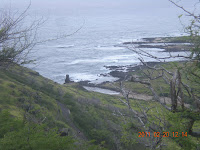Magical Butterflies
Looking out over my sunny Honolulu yard and seeing several beautiful Monarch butterflies flitting from flower to flower makes my heart take flight with them. Trying to catch up to photograph them with my digital camera is a losing proposition, however, although I did manage to get a couple of shots. 
These magical creatures, pulelehua in Hawaiian, are declining in our islands. The main reason is man’s intrusion into their environment: Concrete, pavement, and overbuilding are not favorable butterfly environment. Our use of pesticides damages their immune systems so they are unable to reproduce. Also, many species of birds have decided that the baby Monarch caterpillars are very tasty. Predator lizards, ants and wasps devour their eggs.
There are several butterfly preservation missions in Hawaii, whose purpose is to educate us on the importance of butterflies. They also encourage the creation of butterfly gardens in the midst of our urban areas. Creating a butterfly haven, even if only on your lanai in a crowded city, may help preserve the remaining butterflies. Let’s learn a little about this wonderful being, the butterfly.
Butterfly Life Cycle
Butterflies have four stages of life: egg, caterpillar, pupa, and adult.
After mating, the adult female lays eggs on leaves and stems on a plant the caterpillars will eat (a host plant). The eggs are tiny, and can be round, oval, or cylindrical. The eggs usually hatch within a few days, and tiny caterpillars emerge. Their job now is to eat and grow. Caterpillars are often colorful with interesting stripes or patterns. They will shed their skins at least four times to enclose a rapidly growing body.
Children love to look at and play with the curious looking caterpillars. Generally speaking, the majority of caterpillars are not dangerous to handle, but don’t eat them!
To pupate, the caterpillar finds a sheltered spot and then sheds its skin one last time to reveal the pupa, or chrysalis. Inside the chrysalis, the structures of the caterpillar are broken down and dissolved, and the butterfly’s structures are formed. Then the imago (adult butterfly) emerges.
The adults then experience courtship, feeding, mating, and egg-laying, all within about a two-week period, their life span. Some butterflies can live longer than that, but it’s not typical.
Some interesting butterfly facts:
- Adult butterflies and moths are attracted to certain nectar plants for their food
- Butterflies are pollinators, that help flowering plants to reproduce and bear fruit
- Monarch butterflies eat poisonous plants when they are caterpillars and are poisonous themselves as adult butterflies. If a bird should eat an adult butterfly, he finds that it tastes really bad, and he will become sick and vomit after eating one. No wonder he learns not to do it again!
- The dust on butterfly and moth wings is called scales. The scales form the bright colors, sometimes with hidden ultraviolet patterns. They have several purposes:

- They are signals to the other sex to attract mating
- The colors warn birds or other predators not to eat them
- Their patterns help the butterflies blend into their background and thus escape predators
- Butterflies are cold-blooded. Dark colors formed by the scales can soak up warmth from the sun to allow their bodies to warm up to flight temperatures
- When butterflies cannot keep their temperatures at activity levels, when it's cloudy, or at night, they become inactive. This resting is not the same as human sleep.
- Butterflies always have their eyes open, since they don’t have eyelids, and they probably don’t dream.
These beautiful creatures are declining in our world, but perhaps we can help restore their population! Check with the preservation societies in your area on how you can help.

 While this easy paved trail is scenic at all times of the year, it’s especially popular with hikers of all abilities from November through April, whale-watching season! The islands of Moloka`i and Lana`i may be seen across the Kaiwi Channel, and on a particularly clear day, Maui is also visible.
While this easy paved trail is scenic at all times of the year, it’s especially popular with hikers of all abilities from November through April, whale-watching season! The islands of Moloka`i and Lana`i may be seen across the Kaiwi Channel, and on a particularly clear day, Maui is also visible. 



















